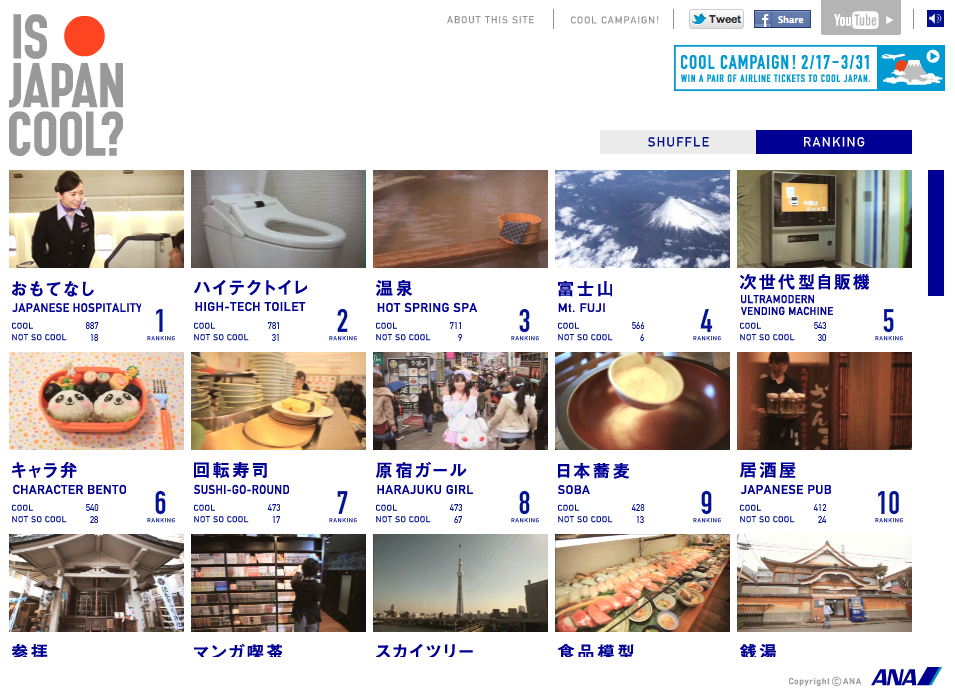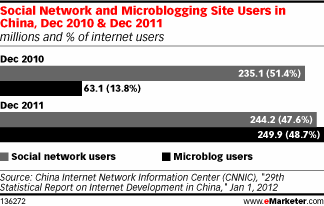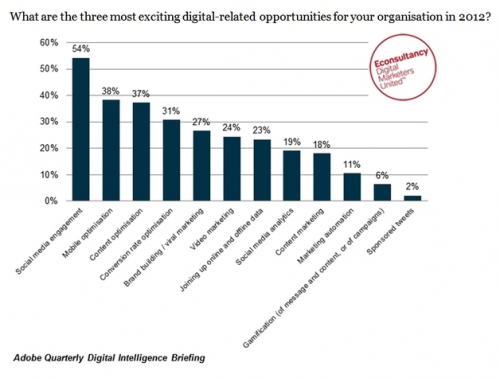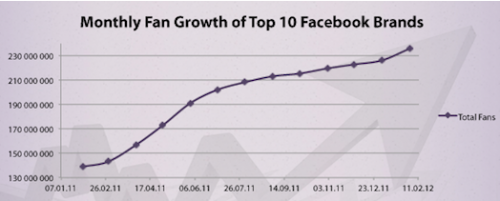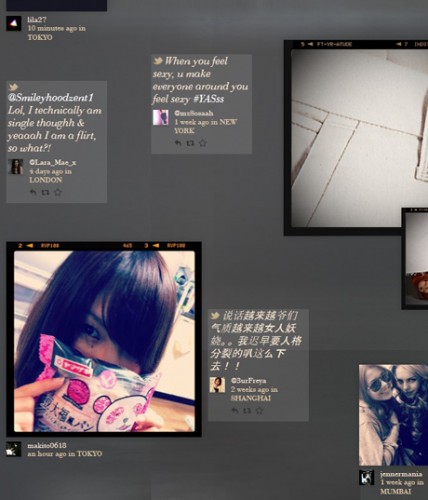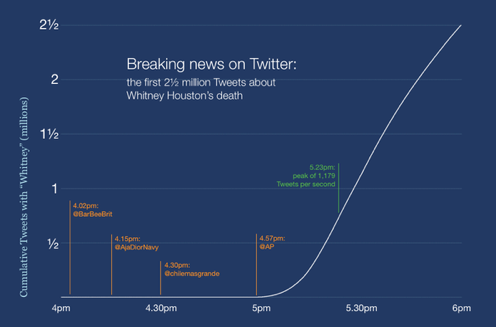We Are Social Asia Tuesday TuneUp #16
Japanese airline ANA shows how Japan is ‘cool’
All Nippon Airways (ANA) is turning to social media to promote tourism to Japan. Its Is Japan Cool? website allows users to share and explore interesting and fun aspects of the country, as well as rate them ‘cool’ or ‘not so cool’. The site itself is simple in functionality and easy to use, even though it could have better integrated social functionalities like the Facebook ‘Like’ to rate items, which would then increase its visibility through Facebook rather than having all the action constrained within the site. ANA is also offering a pair of round-trip tickets to Japan as part of this Cool Campaign, so you might as well try your luck too.
Burberry’s takes London Fashion Week by storm on social media
In addition to our previous post on Burberry’s excellent use of social media to livestream its Autumn/Winter 2012 collection during London Fashion Week, Burberry will be posting looks to its newly launched Pinterest page, and releasing images of its handbags to styling site Polyvore for fans to use in their own fashion collages. It will also make its show soundtrack available for download on iTunes. Before the show, Burberry shared looks from the runway in the form of animated GIF images on Twitter, which is truly novel and refreshing. It’s proven to not only be fashion-forward, but social media-forward as well.
Chupa Chups goes into social gaming
Chupa Chups is leveraging the interactivity and stickiness that social networks afford, and has forayed into social gaming to ensure staying top-of-mind for its target audience. Its first game from Chuck Studios is called Chupa Chucker, in which the brand mascot shoots “brain spam” with lollipops, and was launched yesterday on Facebook. It remains to be seen whether the costs of developing games (there are more in the pipeline) will translate into brand loyalty earned.
Indian Music Service Saavn’s growth from Facebook’s Open Graph
Following the launch of partner apps for Facebook’s Open Graph, India-based Saavn, a service that allows users to share music with friends through their timeline, ticker and news feed on Facebook, has garnered more than 700,000 new users in a month, taking it to a total user base of 1.3 million. It has seen increased usage as a result of Open Graph, with its daily use up by more than 40 times, and content-sharing having increased four-fold. The number of monthly active users have also increased dramatically from 35,000 to 785,000, generating a total of 750 million Facebook impressions along the way. Although based in India, Saavn is available across 200 countries, where its music can be accessed worldwide. No matter how many detractors there are against seamless sharing of Facebook apps, the results sure have been impressive, and show that Facebook users are interested in using these apps.
Microblogs take over China
According to research, micro-blogging (users of Weibo) grew hugely in 2011 in China. Weibo is now slightly more popular than other social networking sites, after growing 296% year-on-year.
It’s unlikely the numbers will increase as much during 2012, due to regulators trying to introduce procedures that would require users to reveal real names while registering.
Asia’s first social media research center
Asia now has its very first dedicated social media research center ‘Social Media Laboratory’, which the Hong Kong University of Science and Technology (HKUST) launched last week. The new facility will study social media culture and technology across Asia, in particular focusing on the research and design of next-generation social media systems, networks, and applications in emerging cyber-physical societies. Professor Tony F Chan, President of the Hong Kong University of Science & Technology said,
“At HKUST, we believe that innovation should play a strong role in the globalized world. We are proud to establish the first social media laboratory in Asia. With this laboratory, our faculty and researchers are taking an active part in nurturing research and development talents in the blooming new arena of social media, and building Hong Kong as a leading hub of creative media and IT technologies in the region.”
A new social network for coffee lovers
Mass niche networks are becoming the next social networks of interest, and Over Coffee is a new social network that is about “coffee, people, travels, and about the shared experiences that take place over a cup of coffee.” After creating their own profile page by registering their details or logging in via their Facebook account, users can upload photos, chat about coffee, use the interactive map to locate cafes in their area, or upload details about their favourite cafes. Users can also blog about their experiences under the ‘Coffee Stories’ section, and submit them to be published as ‘featured stories’. The social element features in ‘Connections’, where users can make connections and meet people, over a coffee perhaps. It’ll be interesting to see how big this ‘social nichework’ can become, given its focus on people’s universal love for coffee.
The ROI of social media
Much has been debated about the ROI of social media. Well, this video addresses most queries that marketers usually have. Most notably, it mentions that
“Because every business has different objectives, ROI will be different for everyone. Before adding social media to any marketing campaign, companies should clearly define their objectives.”
Social media engagement is ‘the top priority for the digital marketer’
Recent research about digital marketing trends shows that social media engagement is rated as the top priority for companies:
New Belgium says “Cheers” to its Fans
According to a study of the No.3 Craft brewer’s annual sales, the average fan spends $260 on beer each year.
Facebook fans really “like” New Belgium beer so much that the amount they spend constitutes to half of the brewery’s annual sales. While it is difficult for brands to measure the impact and value of its customer base, No.3 Craft brewery have a pretty good idea. It estimates that its Facebook fans are responsible for $50.7 million in yearly sales.
Facebook Brand Page growth speeds up – but doesn’t match Google +
Based on figures from Socialbakers, this month alone, the growth of Facebook fans among the top 10 pages has increased to 4.3%.
Nonetheless, Google+ brand pages have grown by an astronomical 1,400% since December. Pages were only introduced a few months ago and at first struggled with limited interaction. The report states that the number of people following the top one hundred brands on Google+ grew from 22,000 to 3.1 million, with the majority of the growth happening in the top ten brands.
Google+ brands have also grown faster than those on Twitter recently in terms of pure numbers, although it’s unclear whether this is really sustainable.
The ciphers of social media
Some really interesting research from Kevin Kelly, with one pertinent take-away: you can’t measure by follower/circle numbers alone, because many of these people are ciphers – they don’t post, and they’re not adding anything ‘social’ to the conversation. In other words, they’re like a newspaper reader, rather than a social networker.
Retailers shutting down F-Commerce sites
Last April, Gamestop opened a Facebook store to generate sales among the 3.5million customers who declared that they were fans of the brand, but less than a year later, the store was quietly shut down. It’s a trend noticeable among other F-Commerce sites, which haven’t performed as expected – with Gap, J.C Penney and Nordstrom all also closing their stores.
Facebook to release timeline for Brands and other new features
Facebook will introduce its Timeline feature to brands this month on a stage-by-stage basis.
In addition, Facebook has also launched verified account status for certain users – you cannot choose to be verified, Facebook will choose you. Once verified, users can show a pseudonym – say, WhatleyDude – instead of their real name.
Facebook is still testing new types of Sponsored Stories based on Open Graph actions like ‘read’, ‘watch’, or ‘listen’. In the test version, people other than those who created the app can buy ads – but it still begs the question as to why they would want to.
Twitter introduces advertising platform for small businesses
Twitter has announced an advertising solution that allows small businesses to set up an advertising account on their own and amplify messages on Twitter. Twitter has teamed up with American Express, to give AmEx cardholders first dabs at this new ad product – the first 10,000 users will receive $100 of free advertising.
Google+ faces demographic problems, releases updates
According to a study, Google+ is overwhelmingly young, male and single – with many students amongst its userbase, and only 30% of users female.
To try and change this, Google have released some new features. First, they’ve added volume bars to the main stream, so users can control how many ‘hot’ posts appear in their stream. Second, they’ve launched a new iOS app with instant upload.
Finally, they’ve added Google+ channel buttons to YouTube, to breed cross-channel promotion. With a Google Latitude leaderboard added to Google Maps, which will reward users for checking in, one can’t help but think that the audience on Google+ will continue to be young, single and male.
YouTube’s new channel rollout helping super-users
YouTube launched 96 new channels in December – but rather than it being brands who’ve grown a userbase quickly, it’s been the old YouTube superusers. In other words, people who’ve done it all before.
Luluvise: a case study in who owns Facebook data?
Luluvise, a female-orientated social network has come under the spotlight for one of its features – WikiDate – where users can rate the men they’ve dated, after linking up with their Facebook profile. After reading The Guardian’s piece, there are serious privacy concerns for us.
Ford’s Fiestagram campaign on Instagram
Ford ran a simple campaign, asking people to upload pictures to Instagram around different topics – but with impressive results. Over seven weeks, they drove over 16,000 photo uploads – and this on a smaller social network like Instagram. Impressive stuff.
Facebook helps Celebrity Big Brother drive more votes
A Facebook app launched by Channel 5 to accompany the latest series of Big Brother saw a large series-on-series increase in votes: according to 5, the app drove around 30% of votes in the series, almost 200,000 in total.
adidas Originals launch Facebook Cover picture app
adidas Originals have launched an app, where users can design their own Cover Photo for their Facebook Timeline. Nice.
Hotels.com launch social booking app on Facebook
Hotels.com have created a clever Facebook app which encourages bookings with friends. The app helps users come to a consensus on which hotel they want to stay in – perfect for anyone booking a group holiday.
Wall Street Journal links up with Instagram and Pinterest for Fashion Week
US newspaper the Wall Street Journal did some good work around New York Fashion Week: with reporters taking pictures anyway as a form of note-taking, they encourage them to upload them to Instagram. The best were then posted on the paper’s main Instagram account, and added to a Pinboard which generated 900 followers during the week.
While this is clearly an innovative use of up-and-coming social networks, it underlines the limited appeal of Pinterest: a platform which is filled with older women should be perfect for a campaign hooked around Fashion Week – and yet even a big newspaper could only drive 900 followers. Be careful of the hype around Pinterest.
Diesel’s ‘Fit Your Attitude’ campaign
Diesel have launched a new app for their female consumers – they answer some attitude-based questions, the app then tells them which jeans to buy, based on social recommendations. There reaches a point where people are making apps for the sake of it. This is that point.
Sainsbury’s seek support from bloggers
Supermarket chain Sainsbury’s sought support from blogger Steven Dresser – a massive Morrisons fan – by inviting him to tour a new megastore. He then wrote about his experience, driving positive word of mouth for Sainsbury’s. Old-school, but effective.
Obama uses hashtags as part of his re-election campaign
These days, you very rarely see a really successful hashtag-centric campaign – butPresident Obama’s #40Dollars campaign has shown that it can work.
Nicolas Sarkozy signs up for Twitter, immediately gets parodied
French President Nicolas Sarkozy created a Twitter account last week around the launch of his campaign for re-election. Shortly after, a bunch of accounts were shut for parodying him – like David Cameron was by the ‘My David Cameron’ viral poster site in 2010. That Twitter was willing to shut down accounts which were clearly a parody is deeply worrying. One to watch.
How Whitney’s death broke on Twitter
The Wall Blog pointed out that Twitter broke the news of Whitney Houston’s death before the press, a point underscored by this graph from Twitter:
